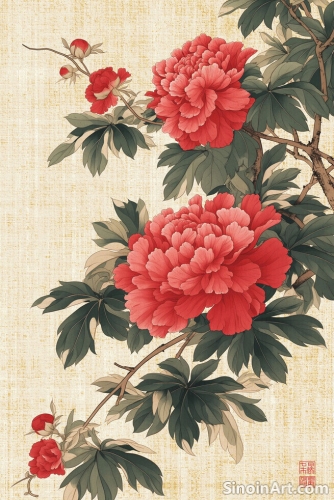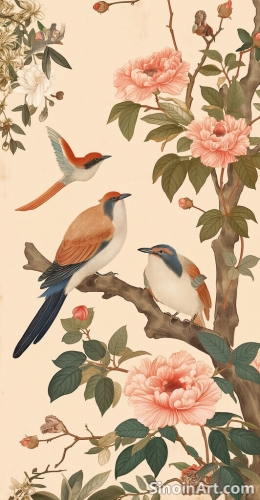A Historical Journey: The Origins of Gongbi Painting
|
The history of Gongbi painting is deeply intertwined with the development of Chinese art itself. Its roots can be traced back to the early dynasties, where the emphasis on precise representation was often used to capture the likeness of emperors, historical figures, and important events. Early forms of Gongbi painting can be seen in tomb paintings and murals, indicating its use in both secular and sacred contexts. The attention to detail and realistic depiction in these early works laid the foundation for the refinement of the art form.  During the Tang Dynasty (618-907), Gongbi reached a significant milestone, evolving into a distinct artistic tradition. The emphasis on elaborate and decorative arts during this period encouraged the development of intricate and meticulously rendered paintings. Gongbi paintings from this era often depicted court life, historical narratives, and the beauty of nature, reflecting the prosperity and sophistication of the Tang court. This period also saw the emergence of influential artists whose works helped establish the core principles of Gongbi.  The Song Dynasty (960-1279) is often considered the golden age of Gongbi painting. Artists during this period achieved remarkable levels of technical proficiency and artistic expression. The themes of nature, especially birds and flowers, were rendered with astounding realism and sensitivity. Court painters refined the techniques, emphasizing accuracy and detail. This was also the period when detailed flower-and-bird paintings became an iconic subject, showcased in many palace and private collections.  Throughout the Ming (1368-1644) and Qing (1644-1912) Dynasties, Gongbi painting continued to flourish, albeit with some stylistic variations. While still emphasizing precise detail, artists in these periods incorporated new artistic influences, expanding the range of subjects and techniques. Landscape painting saw an increase in the precision and complexity, while the depiction of human figures became increasingly refined. The development of new pigment colors also contributed to the unique character of the Gongbi paintings from these later periods. The modern era has seen a renewed appreciation for Gongbi painting, with contemporary artists building upon and revitalizing the traditional techniques. The art form is experiencing a resurgence both in China and internationally. While traditional themes remain popular, contemporary artists are also exploring new subjects and innovative approaches. This continued evolution ensures the legacy of Gongbi painting will endure as a significant form of Chinese cultural heritage. |
Tag : History of Gongbi, Tang dynasty painting, Song dynasty painting, traditional Chinese art history, Chinese art timeline
Related information
- Color in Gongbi: Layering and Luminosity
- Gongbi Color Palettes: From Traditional Pigments to Modern Hues
- Gongbi and the Depiction of Everyday Life
- The Future of Gongbi: Digital Tools and Traditional Techniques
- Gongbi and the Depiction of Jewelry and Accessories
This article explores the use of color in Gongbi painting, highlighting the "ranse" layering method, the use of mineral-based pigments, the process of creating luminous effects, and the overall importance of color in conveying mood and meaning.
Focuses on the color palettes used in Gongbi painting, from traditional natural pigments to modern hues, emphasizing techniques and symbolism.
This article explores the use of Gongbi painting in depicting scenes from everyday life, highlighting its meticulous detail, portrayal of common activities, and how these works serve as visual records of daily existence and a particular time and place.
This article explores the future of Gongbi painting, highlighting the use of digital tools to aid in the creative process, facilitate sharing, and expand the art form’s reach, while emphasizing the importance of maintaining traditional techniques.
This article explores how Gongbi painting depicts jewelry and accessories, highlighting the meticulous detail, use of line and color to convey textures and reflections, and how these objects contribute to the overall cultural and visual richness of the artwork.